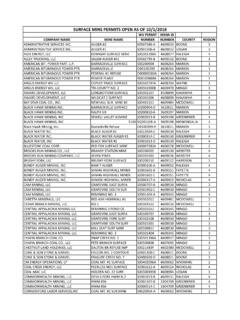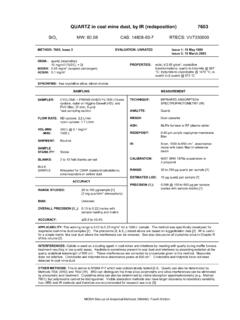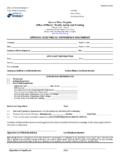Transcription of Gleision Mine Incident
1 Health and Safety ExecutiveGleision Mine Incident 15 September 2011 A factual report by the Health and Safety ExecutiveHealth and Safety ExecutiveGleision Mine Incident 15 September 2011 A factual report by the Health and Safety ExecutiveHSE BooksGleision Mine Incident ii Crown copyright 2015 First published 2015 You may reuse this information (not including logos) free of charge in any format or medium, under the terms of the Open Government Licence. To view the licence visit , write to the Information Policy Team, The National Archives, Kew, London TW9 4DU, or email images and illustrations may not be owned by the Crown so cannot be reproduced without permission of the copyright owner. Enquiries should be sent to guidance is issued by the Health and Safety Executive. Following the guidance is not compulsory, unless specifically stated, and you are free to take other action.
2 But if you do follow the guidance you will normally be doing enough to comply with the law. Health and safety inspectors seek to secure compliance with the law and may refer to this Mine Incident iiiIntroduction 1 Summary of the Incident 1 Background 1 The mine 1 The mine plan 2 Method of work 3 Type of rock in the mine 4 Water in the mine 4 The events of 15 September 2011 4 The search and rescue operation 5 At the site 5 Away from the site 7 The site investigation 7 Preparatory work 7 Mine plans and the mine survey 8 Water flows within the mine 9 Evidence recovered from the mine surface 10 The Main Drift and H1 roadway 11 The Top Road and the old 1980s workings 12 The inrush stall 13 Surveying the inrush stall 16 Other lines of enquiry 16 Calculations 17 Conclusion of the site investigation 18 Securing the mine 18 Legal
3 Framework 18 The Health and Safety at Work etc Act 1974 18 The Management and Administration of Safety and Health at mines Regulations 1994 18 The mines (Precautions Against Inrushes) Regulations 1979 19 Conclusions relating to the site investigation 19 Lessons learned 20 ContentsGleision Mine Incident ivGleision Mine Incident 1 Introduction 1 This report is a factual account of the circumstances of the Incident at Gleision Mine in September 2011 in which an inrush of water from old mine workings resulted in four mine workers tragically losing their lives. It is based on the Health and Safety Executive s (HSE s) involvement in the search and rescue attempt and in the full investigation that followed, which was led by South Wales Police. 2 The report aims to explain what happened, how it happened and why, the investigation process and what evidence was recovered.
4 Where necessary, it contains additional information to aid understanding, for example in relation to mine plans, mining processes and mine water flows. The report does not cover the legal proceedings instigated by the Crown Prosecution Service (CPS) against the former mine manager and owners as these were explored during the subsequent trial in Swansea Crown Court. Summary of the Incident 3 On the morning of 15 September 2011, work was about to start as usual at Gleision Mine, a small coal mine in the Swansea Valley. At around am, the mine manager arrived at the site and, over the next half hour or so, the other eight workers arrived on site. Around am six of the workers went below ground (see paragraph 32). 4 At around am, the first round of explosives was fired (see paragraph 11). The blast released a large body of water from old workings which rushed into the working stall, which was the part of the mine from where coal was being extracted, and where the manager, Malcolm Fyfield, and workers Phillip Hill, David Powell and Charles Breslin were.
5 Two other workers, David Wyatt and Garry Jenkins, were nearby. 5 Such was the volume and speed of the water inrush that four of the men Phillip Hill, David Powell, Charles Breslin and Garry Jenkins were overwhelmed and died. Malcolm Fyfield was injured but managed to escape through the old workings and emerged on the surface about an hour later. David Wyatt and another worker underground, Nigel Evans, who was further away from the stall, just managed to escape to the surface and raise the alarm. 6 A sustained search and rescue operation over the next two days ultimately proved unsuccessful. Over the following days and weeks an initial on-site investigation was started as part of a major joint investigation led by South Wales Police and supported by HSE. The investigation was supported by others from mines Rescue Service Ltd (MRSL) and the nearby Aberpergwm, Unity and Nant Hir mines .
6 Invaluable support was also provided by specialist contractors, equipment suppliers, including Hewden Hire and Pump Supplies Ltd of Port Talbot, and other people with long experience of working small coal mines in South Wales. Their dedication kept the mine accessible for the duration of a very difficult investigation carried out in challenging circumstances. 7 HSE continued to assist South Wales Police beyond the site investigation phase, including helping plan and carry out interviews with key people and organisations. Background The mine 8 Gleision Mine was a small-scale coal mine high on the southern slope of the Swansea Valley, opposite Godre r-graig and near Pontardawe. It was one of very few such mines remaining in the South Wales coalfields. 9 The mine had been owned since 2009 by MNS Mining Ltd who in 2010 had a licence granted by The Coal Authority to extract coal from the No 2 Rhondda Seam.
7 Planning permission granted by Neath Port Talbot County Borough Council limited the extraction of coal to the area defined on The Coal Authority licence. 10 The mine had been working under various owners and managers for many years. Operation was not continuous, there were sometimes years of inactivity. In the five years before the Incident , coal production was intermittent, ownership changed three times and there were five different mine managers. The manager at the time of the Incident , Malcolm Fyfield, was appointed in July 2011 by MNS Mining In the six months before the Incident , Gleision Mine had been producing coal on a single daily shift basis. An average of six miners were employed in this period, as well as a supervisor and mine manager. The method used to get the coal was a traditional bore and fire technique, where holes were drilled into the coal face, explosives were inserted into them and detonated to break out the coal.
8 Gleision Mine Incident 2 The mine plan12 There is a legal requirement for up-to-date plans of mine workings to be kept at the mine. These have to be updated by a qualified mine surveyor every three months, or sooner if the mine workings progress more than 100 m from the last survey point. Looking at the mine plan (Figure 1) will help in understanding the layout of the mine and description of the events. It is marked to show the parts of the mine referred to in this report. The plan is a reproduction of the most recent one updated by the mine surveyor after an inspection he made below ground at Gleision on 3 July 2011 in the company of Malcolm Fyfield. 13 The plan shows the two surface entrances into the mine workings the Main Drift Entrance and the Old North Road Entrance. The latter was not in use at the time as an entrance, but a ventilation fan at the top of it pulled air out of the mine, in turn drawing fresh air in through the Main Drift Entrance and around the mine workings.
9 14 The grey shaded areas on the plan are the parts of the Rhondda No 2 seam that have been extracted over the past 50 years or so. A proportion of these voids is filled with stone packs constructed as part of the mining method in effect the spaces where the coal has been extracted are filled with rock dug out to gain access to them. This provides additional support in those areas. The lines within the shaded areas are the tunnels that gave access to those areas. Most of these are either now inaccessible or very difficult to access. 15 The licence boundary, which is also the area to which the planning permission extended, is marked Colliery Boundary on the mine The grid lines overlaying the plan are spaced 100 m apart and give an idea of the overall scale of the mine. A football pitch would occupy roughly two-thirds of one of the The green hatched areas to the south and east of both the Old South-West Workings and the Old Central Workings seemed to represent the cautionary zone against potentially hazardous disused mine workings.
10 18 Three separate areas of old mine workings, the Old South-West Workings, the Old Central Workings, and the Far-East Workings, are marked in blue with the words Underground Water . 19 There is a blue line drawn on the plan in the Old Central area. The line is near the 109 m contour line which, in the event that there was no connection at a Figure 1 Mine planlower level through which water could run, is the same level as a natural overflow point from the workings. HSE investigators therefore believed that this corresponded to the level of the water in the old workings immediately before the Both the m high Main Drift and the Old North Road tunnels follow the coal seam into the hillside. The Main Drift slopes down at a gradient of about 1 in 5 for about 300 m in a south-easterly direction. Figure 2 shows the view looking down the Main Drift, with a belt conveyor on the left hand side.















